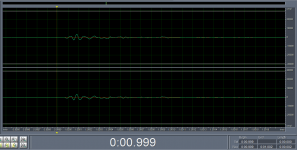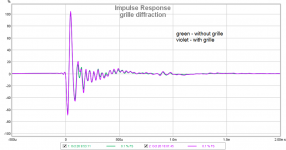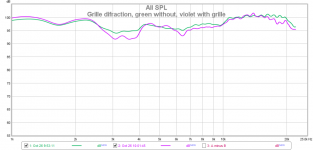Hi Pavel
I think that you misunderstood the two impulse comparison. You would have to leave the microphone in a single location and modify the source to do the comparison. Moving the mic simply changes everything and once again there is no easy way to sort it out.
Hi Earl,
thank you, got it. And thanks for your efforts to find the old documents, it usually takes long time when we want them again after years 😉.
Hi Earl,
I hope this time it might be the measurement that you have suggested. 2 impulse responses, same mic and speaker position in both measurements, small acoustic change. Difference of impulse responses shown as well.
I still assume this reflects in frequency domain (and it does) as well, as frequency and time domain are necessarily dual representation of the same thing.
I hope this time it might be the measurement that you have suggested. 2 impulse responses, same mic and speaker position in both measurements, small acoustic change. Difference of impulse responses shown as well.
I still assume this reflects in frequency domain (and it does) as well, as frequency and time domain are necessarily dual representation of the same thing.
Attachments
^I would like to see the difference in spl/F response too! I am not experienced enough to see it from impulse...
Last edited:
Actually dipoles can image rather wellYou also won't hear any imaging either.
^I would like to see the difference in spl/F response too! I am not experienced enough to see it from impulse...
OK, this is a similar measurement in both time and frequency domain, these measurements form a pair. The difference is that the green one is without grille and the violet one is with grille. The front baffle is 20cm wide and it is measured at a distance 44cm from the front baffle, on tweeter axis. We may call it a "grille diffraction".
Attachments
Yes, of course you can see the difference and this might be diffraction, but it might also be just absorption, that would depend on the grill. That's a pretty bad grill IMO. I suspect that you can hear that, although to be valid, it would have to be blind. But I think that the point is that one can see differences in the impulse, which do have a correspondence in the frequency response, except that with the impulse response you can tell at what time the problem occurs, something that is not readily apparent from the frequency response. In this example the time is not large, but sometimes it can be. The greater the time lag of these kinds of problems the more audible they become AND the more audible they become at higher SPLs. That's why I look in the time domain as well as the frequency domain.
To be clear on the point that I am trying to make consider this. If you take the difference impulse and delay it some more and then add it back to the original impulse then you will not see much effect on the frequency response magnitude. But the increased delay effect will be more audible and the audibility will grow faster as the level is increased.
To be clear on the point that I am trying to make consider this. If you take the difference impulse and delay it some more and then add it back to the original impulse then you will not see much effect on the frequency response magnitude. But the increased delay effect will be more audible and the audibility will grow faster as the level is increased.
Just in time for Halloween, the scary diffraction goblin is turning into an invisible ghost.
B.
B.
I think there might be better examples than that I have shown. Maybe Earl might like to teach us, with some of his measurements?
Based on my/our research I became aware of the problems with diffraction-like signals in the output stream. For that reason I went about trying to minimize them in every way that I could. I did not do measurements along the way, step-by-step, but only the final results. I found that as I minimized diffraction both in the speaker as well as the room in the vicinity of the speaker the sound quality improved. This was consistent with what should happen based on our research, but was not heavily documented. The only example that I have was what I showed earlier.
We need to understand that timing IS a factor and that frequency response magnitude does not tell us that. Anyone who believe that frequency response alone is all we need to know does not understand the psychoacoustics. The ear is a very temporal device, NOT an FFT.
And again, the diffraction issues are not dominate effects, frequency response of the direct field is more important, and then the DI(f) but as that gets smoother and smoother then the timing of the errors becomes important. If you look at the impulse responses that I showed earlier they are extremely clean and compact. Unless you have that you will not see or notice what I am talking about.
The ones that Pavel posted are not terrible, but certainly not as precise and compact as what I showed.
We need to understand that timing IS a factor and that frequency response magnitude does not tell us that. Anyone who believe that frequency response alone is all we need to know does not understand the psychoacoustics. The ear is a very temporal device, NOT an FFT.
And again, the diffraction issues are not dominate effects, frequency response of the direct field is more important, and then the DI(f) but as that gets smoother and smoother then the timing of the errors becomes important. If you look at the impulse responses that I showed earlier they are extremely clean and compact. Unless you have that you will not see or notice what I am talking about.
The ones that Pavel posted are not terrible, but certainly not as precise and compact as what I showed.
Just in time for Halloween, the scary diffraction goblin is turning into an invisible ghost.
B.
Yes, the clowns are also coming out for the season.
Anyone who believe that frequency response alone is all we need to know does not understand the psychoacoustics. The ear is a very temporal device, NOT an FFT.
Yes, however we should admit both a and b. The ear is first a temporal device ("first" meaning in time domain, early), second (then) a FFT device. First/transient orientation is in time domain, then frequency domain prevails.
I am not sure that temporal is first, frequency response is likely to be the most important, but we cannot simply ignore the temporal as if it isn't an issue.
Sorry, I am not a native speaker. "First" I mean on time axis. In first hundreds of microseconds, maybe milliseconds we locate the sound based on time difference between L and R ear. Then, after some time, we perceive timbre etc.
Yes, I agree with you now. We determine localization very rapidly and tembre takes more time. Timbre is strongly influence by the room, localization not so much unless there are some very early reflections, which can occur if the speakers are near the walls.
Yes, I agree with you now. We determine localization very rapidly and tembre takes more time. Timbre is strongly influence by the room, localization not so much unless there are some very early reflections, which can occur if the speakers are near the walls.
Great, I see we are making progress.
Tone colour (AKA timbre) is influenced by the polar response. And diffraction will have a tiny sort-of random influence on tone colour if there is appreciable audible diffraction.
But localization depends on sound differential between the two speakers. Even if you had mammoth Halloween-sized colouration (of which diffraction might contribute a tiny amount), you still wouldn't influence localization if comparable in both speakers.
After all, the crossover with 10%-spec components, and a bunch of other asymmetries of the electronics and the room and your ears all together cause far larger asymmetries than any wee bit of sort-of random diffraction.
Certainly puzzles me why some enthusiasts keep on beating this dead horse as if diffraction mattered.
B.
B.
Linkwitz shows that diffraction just isn't an audible problem except maybe a bit for minuscule sized boxes.
His data, which indicate little harm from diffraction, are absolutely worst-case. And these tests are further worse because being purely on-axis and anechoic, they miss the Peter/Paul principle (even with diffraction occurring, total room sound is not changed).
B.
I didn't get that from his article. Diffraction is clearly a real and measurable thing. He says its difficult to predict accurately and unproven how much of an effect it has.
But how does one prove how bad something sounds? Not easily. Do you believe in imaging? Its hard to measure or quantify as well.
Also your analogy makes no sense. The sound is measurably changed.
Here is a good example how low diffractions can be in a basically standard narrow floorstander. Narrowing front baffle aroud tweeter and chamfered edges. Nicely mounted drivers with exceptional radiator profile - shallow dome or inverted dome. Smart xo and time alignment.
So, to me this shows that baffle shape doesn't have to be special. Besides Tidal, Magico can do this too.

Normalized horizontals
Tidal Audio Akira loudspeaker Measurements | Stereophile.com
Its hard to see the effect from the graph. But it seems most high end speakers have some kind of diffraction control. A DIY'er could use a big belt sander and get even smoother lines. The trend seems to be make the box as narrow as possible which does cut down diffraction.
Perhaps it has been a long time since you read Toole's book.
Without disputing the exact role of direct sound (which, like Linkwitz and other dipole enthusiasts I might wonder about), I have yet to hear any intelligent reason to think that diffraction has anything to do with image localization.
Want to try to explain how diffraction affects localization?*
And please do not again accuse me of trolling.
B.
*Maybe localization would have an effect for a recording of a marching band walking around. Not sure.
Do you believe that humans can tell where sound comes from? If so how? Changes in frequency response caused by things like reflection and diffraction is as good an explanation as any.
Actually dipoles can image rather well
I would assume they image fine with space around them. I still think a point source would image the best. Directivity doesn't necessarily help imaging, unless there are early reflections.
So sod the text and look at pictures. Measurements > talking.
Diffraction from baffle edges
YouTube
There's lots of basic background info in this video, so jump to approx 4:30 and 10:00 for the good bits.
The clip gives good support for doing a chamfer rather than a simple rectangle - and the chamfer doesn't have to be ridiculously huge, as some suggest.
Saw that video. Its really the how the brain interprets the sound that matters the most. But the fact that something can be measured is a step in the right direction. I believe I can hear diffraction, as opposed to changes from swapping wires or some of the other stuff people claim.
Last edited:
Certainly puzzles me why some enthusiasts keep on beating this dead horse as if diffraction mattered.
You still don't get it and your posts are getting annoying and bordering on rude, so I am done trying to explain it to you. Why do you keep posting here since you clearly don't buy anything that the rest of us believe.
Rather well. But it can feel as though I'm hallucinating. Like the room has been turned inside-out and used to neatly dress the image.Actually dipoles can image rather well
The two parts, spaciousness and imaging seem spatially unrelated on experiencing them. If I ever had to take this to the next level it would be omnidirectional, rather than dipole.
I think I know what you mean. It's not a precise image in space possibly. I like listening to both dipole and monopole, in fact I can "convert" the speakers I have, Jordan Eikona VTL, by removing the rear panel, they are very shallow enclosures, and whilst not a perfect dipole are very similar in size to Linkwitz's Phoenix speaker and work very well with bass support. I'm interested in omnidirectional too but never heard any
- Home
- Loudspeakers
- Multi-Way
- Baffle Diffraction
